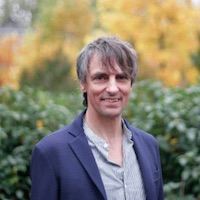Sri K Pattabhi Jois frequently made the statement “weak body, weak mind”, and similarly he liked to quote the yoga scripture that says: the Self cannot be attained by the weak.
These statements are in keeping with his emphasis on the value of ashtanga’s third limb: asana practice. He taught that practicing asana makes you strong, not only physically but eventually in every way, and this includes learning to highly value and follow the ethical guidelines of the yama’s and niyama’s, limbs one and two.
Asana could be thought of as the root limb that forms the foundation for all the other limbs. This is because working with your body in the postures puts you right in the center of the gritty details of what’s inside of you in a ‘hands on’, physical and practical way that circumvents the static habit patterns of the mind. One time this little exchange took place between Guruji when I was saying good bye to him after practice:
Me: Oh today, my back stiff.
Guruji (with riveting eyes and slightly mock seriousness): Much thinking, too much thinking is there.
For success in yoga it is vitally important not to forget about the body in favor of thought, there can be a tendency to be ‘non physical’ when thinking, and to somehow think that being intellectual is superior to being physical. In truth creative thought emerges directly out of a receptive body. To isolate thought while neglecting the body can create unwanted distance between you and your perceptions and remove you from your visceral connection to your experience.
Shifting the limbs and putting asana before the ethics of the yama’s is an acknowledgement that I can’t exclusively think my way to letting go of my aggression, greed, jealousy, and my tendencies towards egotism, complacency and lethargy. I have to get physical. I have to build up my physical and mental power through asana, pranayama, and dhyana and then I can ‘take on’ my mind, I can take on correcting the diseased behaviors that follow from my inability to see through greed, anger and the host of aberrant desires and aversions that can impulsively take center stage.
The body is the home of my animal sense, my aliveness to the multiplicity of vivid, subtle, unique, real sensations that are taking place within me in each moment. Asana practice can teach me the necessity of allowing thought to be born out of bodily awareness, out of feeling, sensing, and perceiving in a very distinctly animal way.
An animal has to continually tune in to the outer environment, survival depends on his ability to fully inhabit his body in order to respond to this environment. Inhabiting the body means being fully awake in a deeply physical, multi sensual way—awakening to promptings of the eyes, ears, heart, voice, feet, hands, skeleton, brain, spine, limbs and all. There has to be a total, automatic trust in the body, and this requires true physical intimacy and inhabitation.
Great beauty and potent, powerful strength can result when you learn to see your practice as an endeavor to so totally trust your body. When you practice with direct immediacy, with devotion and love for what you are doing then a distinctly human expression of this animal trust can emerge. And it begins with a recognition that the body is the foundation, the ground, the home and the first basis for the self reflection and expansion of consciousness that psychological and spiritual growth require.
What I have written above has been true for me. Yoga has been slow, intensely physical process of waking up to what is most alive within me and following through to express what I have received from my efforts. At first my mind often hindered me in this process; instead of helping me my thinking would vex, frustrate and thwart me in my efforts to grow and understand things about my self. I find that asana has been the necessary starting point for the process realizing the potency and extent of my energy, and of learning how to harness and direct that energy. Practice continues to be the all important physical ‘doing’ of realization, of knowing my Self.
The world of asana is where I apply my self to the trade of learning how best to twist, to bend forward and backward and such. Because in order to do these things at a high level and with much more soul than mere competence, not only my physical power is required, but also my brain, nervous system, intelligence, my heart, and mental powers of concentration need to be thoroughly engaged.
I am then not only bending and twisting to strengthen, ‘stretch’ or for exercise, but also to hone in, to redirect my senses, to inhabit the body, to enjoy the ‘Large View’, the highly developed view of a connoisseur, the appreciative view that leads to the spectacular view of spirit.
~
Editor Tanya L. Markul











Read 13 comments and reply